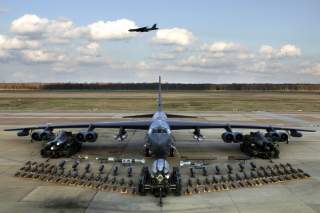The B-52 'Arsenal Plane': America's Super Bomber Is Set for a Massive Upgrade
The Air Force is already upgrading the historic, 1960s-era bomber with new radios, avionics and weapons capability
“The crew gets the ability to communicate digitally outside the airplane which enables you to import not just voice but data for mission changes, threat notifications, targeting….all those different types of things you would need to get,” Single said.
An ability to receive real-time targeting updates is of great relevance to the B-52s close-air-support mission because fluid, fast-moving or dynamic combat situations often mean ground targets appear, change or disappear quickly.
Alongside moving much of the avionics from analogue to digital technology, CONECT also integrates new servers, modems, colored display screens in place of old green monochrome and provides pilots with digital moving-map displays which can be populated with real-time threat and mission data, Single said.
The new digital screens also show colored graphics highlighting the aircraft’s flight path, he added.
Single explained that being able to update key combat-relevant information while in transit will substantially help the aircraft more effectively travel longer distances for missions, as needed.
“The key to this is that this is part of the long-range strike family of systems — so if you take off out of Barksdale Air Force Base and you go to your target area, it could take 15 or 16 hours to get there. By the time you get there, all the threat information has changed,” said Single. “Things move, pop up or go away and the targeting data may be different.”
The upgrades will also improve the ability of the airplane to receive key intelligence information through a data link called the Intelligence Broadcast Receiver. In addition, the B-52s will be able to receive information through a LINK-16-like high-speed digital data link able to transmit targeting and Intelligence, Surveillance and Reconnaissance, or ISR information.
The CONECT effort, slated to cost $1.1 billion overall, will continue to unfold over the next several years, Single explained.
Twelve B-52 will be operational with CONECT by the end of this year and the entire fleet will be ready by 2021, Single said.
B-52 History:
Known for massive bombing missions during the Vietnam War, the 159-foot long B-52s have in recent years been operating over Afghanistan in support of military actions there from a base in Guam.
The B-52 also served in Operation Desert Storm, Air Force statements said. “B-52s struck wide-area troop concentrations, fixed installations and bunkers, and decimated the morale of Iraq's Republican Guard,” an Air Force statement said.
In 2001, the B-52 provided close-air support to forces in Afghanistan during Operation Enduring Freedom, service officials said. The B-52 also played a role in Operation Iraqi Freedom. On March 21, 2003, B-52Hs launched approximately 100 CALCMs (Conventional Air Launched Cruise Missiles) during a night mission.
Given the B-52s historic role in precision-bombing and close air support, next-generation avionics and technologies are expected to greatly increase potential missions for the platform in coming years, service officials said.
Kris Osborn became the Managing Editor of Scout Warrior in August of 2015. His role with Scout.com includes managing content on the Scout Warrior site and generating independently sourced original material. Scout Warrior is aimed at providing engaging, substantial military-specific content covering a range of key areas such as weapons, emerging or next-generation technologies and issues of relevance to the military. Just prior to coming to Scout Warrior, Osborn served as an Associate Editor at the Military.com. This story originally appeared in Scout Warrior.

